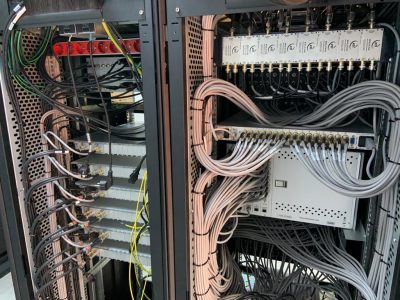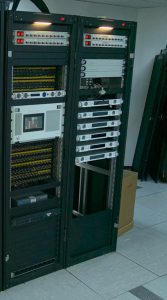 Expanding its constellation with the addition of two new satellites, the primary satellite communications and cable TV operations company in Turkey – Türksat has built new ground infrastructure to match the new technological advancements it is making in the sky.
Expanding its constellation with the addition of two new satellites, the primary satellite communications and cable TV operations company in Turkey – Türksat has built new ground infrastructure to match the new technological advancements it is making in the sky.
Turksat’s 5A, which launched on the 8th of January 2021 will be joined by 5B in June 2021. These are two new-generation communication satellites, built by Airbus, operating in Ku- and Ka- band. With an expected life-span in orbit exceeding 30 years, they will both sit in geostationary orbit, with beams covering Turkey, the Middle East, Europe, North Africa and South Africa – significantly expanding Türksat’s capabilities.
To ensure seamless project delivery, Türksat brought in trusted partner and turnkey system integrator Pals Electronics to design, procure and project manage the ground infrastructure development required ahead of the launch. Here, Mohamad Barada, International Sales Manager at ETL Systems, a firm introduced to the project by Pals, outlines how Türksat is taking advantage of reengineered modular hot-swappable ground segment equipment to bring down cost and increase capabilities without impacting resilience or reliability.
Expanding capabilities
According to a recent survey by the Turkish Statistical Institute (TÜİK), internet usage among Turks aged between 16 and 74 rose to 79 per cent in 2020 from 75.3 per cent the previous year. From consumers streaming HD video, to businesses conducting video conferencing calls or even the government using telemedicine applications in hospitals, usage is diverse and wide-ranging.
With the growing demand for services Türksat needed to expand its image, voice and data communication capability, with a big aim to take their place amongst just 10 countries in the world able to produce communications satellites domestically, with Türksat 6A also planned for in-orbit delivery in 2022.
 Ensuring reliability
Ensuring reliability
From the outset, it was acknowledged that new ground infrastructure would need to replace legacy systems, not just for 5A and 5B, but also for the remaining satellites in the Türksat constellation.
Pals and Türksat knew they needed new frequency converters and RF matrices in place to deliver a robust Telemetry, Control and Ranging (TCR) system and to ensure reliability of service for vital links.
Via the TCR, system-critical data monitors the health of the satellites with key metrics reported back from the spacecraft. These links are also key to pinpointing the location of the satellites, and when required, taking control to direct their propulsion systems from the ground, to adjust exact location and ensure their continued operability.
With broadcasters relying on 5A to be fully operational at all times, as well as data customers from Turkey to South Africa requiring an always-on high throughput link, the TCR systems are integral in ensuring service level agreements are always met.
Choosing the best equipment
Thanks to smart engineering, each of the four new earth stations, located in Ankara, have been designed to require relatively few antennas. A four-port VSAT antenna with two uplinks and two downlinks is all that’s required when combined with ETL’s Falcon L-Band to IF Agile Frequency Downconverter modules and Falcon IF to L-band Agile Frequency Upconverters.
Each of the converter modules has also been populated in ETL’s new Genus smart chassis, enabling RF equipment, frequency converters, amplifiers, switch matrices and RF over fibre technologies to be hot-swapped in and out of a single chassis in a modular way.
The chassis itself is also smart, forming a habitat which tracks which modules are installed and records the operational history of the unit alongside other factors like heat, humidity, operational cycles and other important environmental and functional data. Not only does this prevent against performance decline, it will also ensure a reliable service for Türksat customers.
Each of the RF system modules can also be hot-swapped, meaning there can be common spares provisioning and significant rack space-saving all housed in a robust habitat configured to suit high resilience applications.
 The new earth stations are also equipped with ETL’s Victor RF matrices which have a module capacity of up to 16 Inputs x 16 Outputs, 50-2500MHz – KA-band ready frequency and local and remote control and variable gain, all in a compact 1U high shelf. The Enigma distributive matrix, with a larger 6U rack enclosure is also deployed to facilitate maximum performance and redundancy.
The new earth stations are also equipped with ETL’s Victor RF matrices which have a module capacity of up to 16 Inputs x 16 Outputs, 50-2500MHz – KA-band ready frequency and local and remote control and variable gain, all in a compact 1U high shelf. The Enigma distributive matrix, with a larger 6U rack enclosure is also deployed to facilitate maximum performance and redundancy.
As well as saving a lot of rackspace, in-field upgrades will also be much easier and more flexible, with additional modules able to be added to an existing chassis if later required. Up-converters can be combined with down-converters as and when required, and hot-swapped in and out with ease.
With Türksat 5A now settling into its place in orbit, the launch of Türksat 5B only a matter of months away and Turkey’s first fully domestic satellite – Türksat 6A – planned for in-orbit delivery in 2022, there’s no denying the huge technological advancements being achieved in orbit and on earth.
By taking advantage of ETL’s latest RF matrices and modular hot-swappable ground segment equipment, Türksat has achieved their aim of increasing their capability, while bringing down cost and ensuring uncompromised reliability.












Add Comment